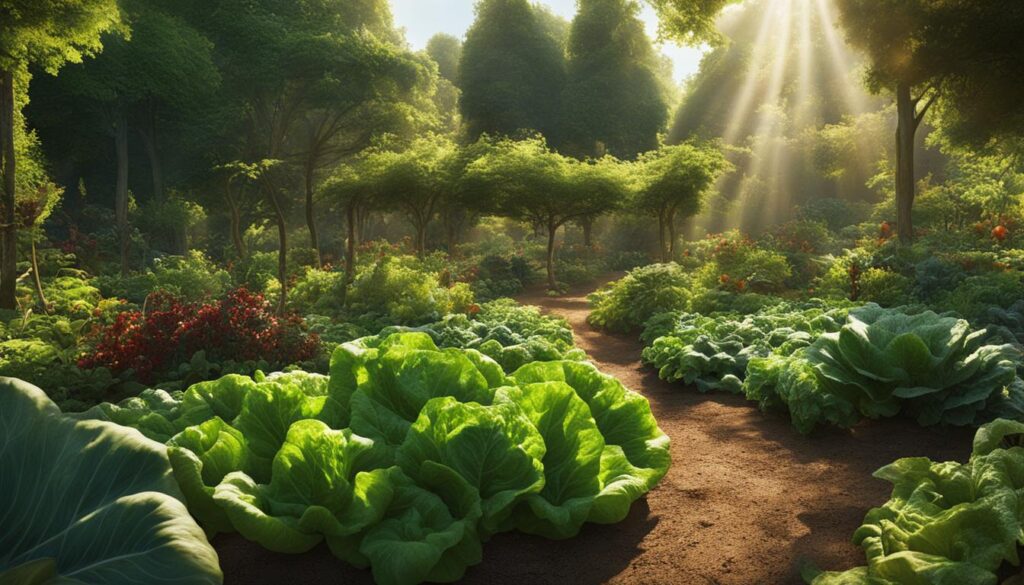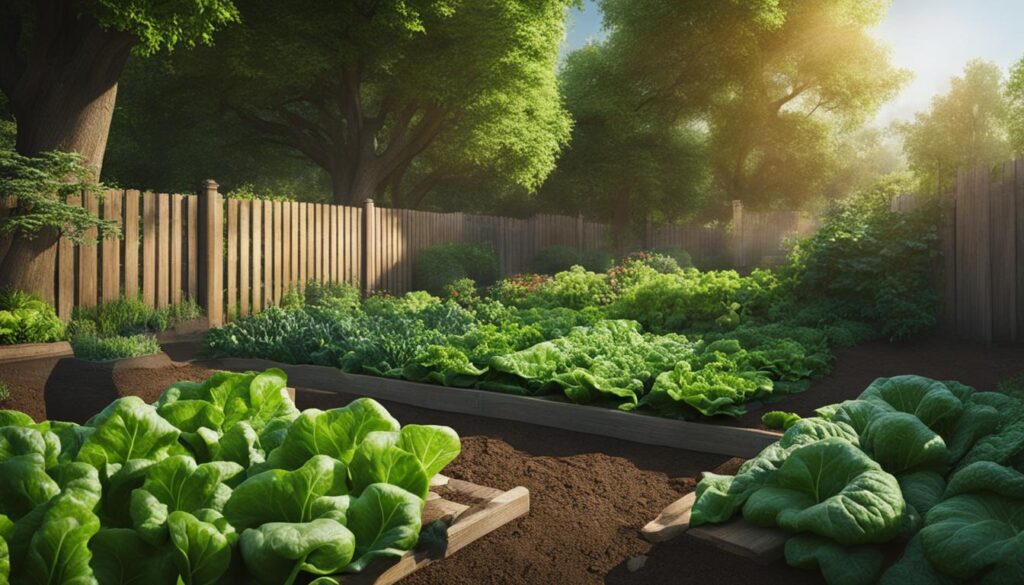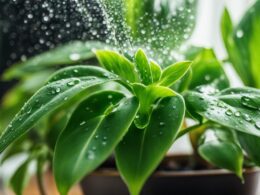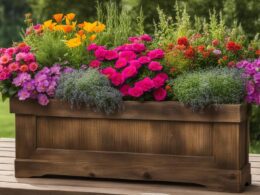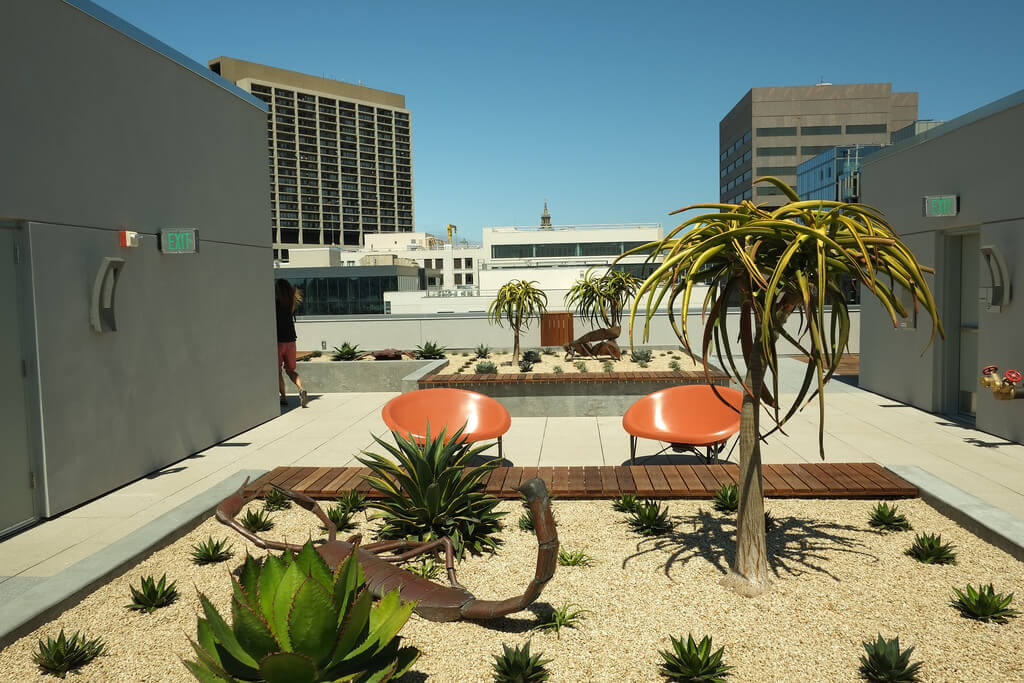Are you a Texas gardener looking to make the most of your shaded areas? Good news! You don’t have to limit your green thumb to sunny spots. There are plenty of vegetables that can thrive in partial shade or part sun conditions, making them perfect for gardening in the shade in Texas.
While some fruiting vegetables require full sun, there are numerous shade-tolerant crops that can still yield a bountiful harvest with just 3 to 6 hours of direct sunlight per day. By assessing the light levels in your garden and understanding the different levels of shade, you can plan a shade-friendly garden that will provide you with a variety of Texas-friendly crops.
When it comes to shade gardening in Texas, cole crops like broccoli, cauliflower, and kale are tolerant of partial sun or partial shade. Root crops such as radishes and carrots can grow in as little as 3-4 hours of direct sun. Leafy greens like lettuce, arugula, and chard are happy with just a few hours of sunshine each day. And climbing vegetables like cucumbers and pole beans can do well in areas that are shaded in the morning but sunny in the afternoon. Perennial vegetables like rhubarb, asparagus, and Jerusalem artichokes can also be grown in partial sun or partial shade.
To make the most of your shade garden, it’s important to choose the right vegetables and understand their specific light requirements. By doing so, you can create a thriving garden that will yield a bountiful harvest of shade-tolerant vegetables, even in areas with limited sunlight.
Post Summary
- Many vegetables can grow in shade in Texas with 3 to 6 hours of direct sunlight per day.
- Cole crops like broccoli, cauliflower, and kale tolerate partial shade.
- Root crops like radishes and carrots can grow in as little as 3-4 hours of direct sun.
- Leafy greens like lettuce, arugula, and chard thrive with just a few hours of sunshine each day.
- Climbing vegetables like cucumbers and pole beans can do well in shaded morning areas.
- Perennial vegetables like rhubarb, asparagus, and Jerusalem artichokes can be grown in partial sun or shade.
Vegetables That Grow Well in Shade
When it comes to gardening in shady areas, there are several vegetables that thrive without the need for full sun. These shade-tolerant vegetables are perfect for shady gardens or areas with limited sunlight. By selecting the right vegetables, you can still enjoy a bountiful harvest even in the shade.
Cole crops like broccoli, cauliflower, kohlrabi, turnips, kale, and rutabagas are excellent choices for shady gardens. These vegetables can tolerate less than a full day of sun and may take longer to mature, but they can still produce quality crops. Cabbage is another shade-tolerant option, although tightly formed heads may not develop.
Root crops such as radishes, carrots, potatoes, and beets can also thrive in shade. These vegetables can grow in as little as 3-4 hours of direct sun, with light or dappled shade for the rest of the day. Leafy greens like lettuce, arugula, kale, bok choy, and chard are great options for shady gardens too. They can thrive with just a few hours of sunshine each day, and keeping them out of midday sun can prevent wilting.
Other shade-tolerant vegetables include climbing varieties like cucumbers and pole beans. These vegetables can do well in areas that are shaded in the morning but receive sunshine in the afternoon. Additionally, perennial vegetables like rhubarb, asparagus, and Jerusalem artichokes can be successfully grown in partial sun or partial shade. These vegetables require less sunlight to thrive, making them ideal choices for shady gardens.
Vegetables That Grow Well in Shade
| Vegetable | Light Requirements |
|---|---|
| Broccoli | Partial shade |
| Cauliflower | Partial shade |
| Kohlrabi | Partial shade |
| Turnips | Partial shade |
| Kale | Partial shade |
| Rutabagas | Partial shade |
| Cabbage | Partial shade |
| Radishes | Partial shade |
| Carrots | Partial shade |
| Potatoes | Partial shade |
| Beets | Partial shade |
| Lettuce | Partial shade |
| Arugula | Partial shade |
| Kale | Partial shade |
| Bok choy | Partial shade |
| Chard | Partial shade |
| Cucumbers | Partial shade |
| Pole beans | Partial shade |
| Rhubarb | Partial shade |
| Asparagus | Partial shade |
| Jerusalem artichokes | Partial shade |
By incorporating these shade-tolerant vegetables into your garden, you can create a thriving oasis even in areas with limited sunlight. Enjoy the benefits of homegrown produce and the satisfaction of a successful shade garden.
Vegetables That Don’t Grow Well in Shade
While many vegetables can tolerate partial shade, there are some that require full sun to grow and thrive. These sun-loving vegetables need hot, sunny days in order to produce quality fruit. If your garden has limited sun exposure, it’s important to recognize the sun requirements of these vegetables and plan accordingly.
| Vegetable | Sun Requirement |
|---|---|
| Tomatoes | Full sun (6-8 hours per day) |
| Peppers | Full sun (6-8 hours per day) |
| Eggplant | Full sun (6-8 hours per day) |
| Squash | Full sun (6-8 hours per day) |
| Melons | Full sun (6-8 hours per day) |
| Citrus Trees | Full sun (6-8 hours per day) |
| Peach Trees | Full sun (6-8 hours per day) |
| Apple Trees | Full sun (6-8 hours per day) |
These vegetables require direct sunlight for optimal growth and won’t thrive in shade. It’s best to focus on shade-tolerant vegetables when you have limited sun exposure in your garden, ensuring you can still enjoy a bountiful harvest. By selecting the right vegetables and understanding their sun requirements, you can create a successful and productive garden even in areas with less sunlight.
Remember:
- Tomatoes, peppers, eggplant, squash, and melons need full sun (6-8 hours per day) to produce quality fruit.
- Citrus, peach, nectarine, apple, and apricot trees also require full sun for optimal growth.
- Choose shade-tolerant vegetables for gardens with limited sun exposure.
“Understanding the sun requirements of your vegetables is crucial for a thriving garden. While some crops can tolerate shade, others thrive in full sun. By selecting the right vegetables for your garden’s light conditions, you can ensure a successful harvest.”
Tips for Growing Vegetables in Shade
Gardening in the shade requires careful planning and thoughtful cultivation techniques to maximize light penetration and ensure the healthy growth of your vegetables. Here are some tips to help you successfully grow vegetables in areas with limited sunlight:
- Assess the Light Levels: Before you start planting, it’s essential to evaluate the amount of sunlight your garden receives. Determine if your garden gets morning sun with afternoon shade or if it’s consistently shaded throughout the day. This information will guide your vegetable selection and planting strategy.
- Reflective Surfaces: To maximize light penetration in shady areas, consider using reflective surfaces such as white-painted walls, fences, or mirrors. These surfaces can help bounce available light onto your plants, providing them with additional brightness.
- Utilize Cold Frames and Row Covers: In shadier corners of your garden, you can extend the growing season by using cold frames or row covers. These structures help trap heat and create a microclimate that is more suitable for vegetable growth.
- Combat Slugs and Snails: Shady areas tend to attract slugs and snails, which can damage your vegetable plants. To prevent their infestation, set up beer traps or use organic slug control methods. Additionally, delaying mulching until the weather warms up can discourage these pests from taking shelter in your garden.
- Optimize Plant Spacing: Proper plant spacing is crucial in shade gardening as it allows each plant to receive adequate light. Follow the recommended spacing guidelines for your chosen vegetables to ensure optimal growth and prevent overcrowding.
- Adjust Watering: While vegetables in shaded areas may require less water than those in direct sunlight, it’s important to monitor the moisture levels in your garden. Adjust your watering schedule accordingly, making sure not to overwater or underwater your plants.
By implementing these tips, you can create a thriving shade garden and enjoy a bountiful harvest of fresh, homegrown vegetables.
Expert Tip: Choose shade-tolerant varieties
When selecting vegetable varieties for shade gardening, look for those specifically bred for low-light conditions. These shade-tolerant varieties have adapted to thrive in environments with less sunlight. They are more likely to produce satisfactory yields even with limited sun exposure. Check with local garden centers or seed suppliers for recommendations on shade-tolerant vegetable varieties that are suitable for your region.
Conclusion
Gardening in the shade in Texas can be a rewarding experience when you choose the right shade-tolerant vegetables. While some vegetables thrive in full sun, there are numerous crops that can flourish with just a few hours of direct sunlight per day. By selecting shade-friendly vegetables, you can enjoy a productive harvest even in areas with limited sun exposure.
Vegetables such as cole crops like broccoli, cauliflower, and kale, root crops like radishes and carrots, and leafy greens such as lettuce and chard are all well-suited for growing in the shade. By understanding the light levels in your garden and choosing the right vegetables, you can create a thriving shade garden that yields fresh and nutritious produce.
Maximizing light penetration is key when gardening in the shade. Assess the sun exposure in your garden and plan accordingly. Reflective surfaces like white walls, fences, and mirrors can help redirect available light to shadier areas. Utilizing cold frames and row covers can extend the growing season in shadier corners. Additionally, adjusting plant spacing and watering frequency can optimize growth and productivity.
With the right knowledge and techniques, you can successfully grow vegetables in shade and enjoy the benefits of homegrown produce. Embrace the possibilities of gardening in the shade and savor the flavors of your bountiful harvest.
FAQ
Can I grow vegetables in shade in Texas?
Yes, many vegetables can thrive in partial shade or part sun conditions in Texas. There are numerous crops that can tolerate and even thrive with 3 to 6 hours of direct sunlight per day.
Which vegetables can grow well in shade?
Shade-tolerant vegetables include cole crops like broccoli, cauliflower, and kale; root crops like radishes and carrots; leafy greens such as lettuce and chard; and climbing vegetables like cucumbers and pole beans.
Are there vegetables that require full sun to grow?
Yes, heat-loving crops like tomatoes, peppers, eggplant, squash, and melons require full sun to produce quality fruit. Most fruit trees also require direct sun and won’t thrive in shade.
What tips can you give for growing vegetables in shade?
Assess the amount of sun your garden receives and plan accordingly. Reflect available light into shadier parts of the garden, warm up shadier corners with cold frames or row covers, prevent damage from slugs and snails, adjust plant spacing for light penetration, and consider adjusting watering frequency when gardening in the shade.
Is it possible to have a successful shade garden in Texas?
Yes, by choosing shade-tolerant vegetables, assessing light levels, and following tips for maximizing light penetration, you can create a thriving shade garden and successfully grow vegetables even in areas with limited sun exposure.
How can I involve my kids in planting and growing shade-friendly vegetables in Texas?
Get your kids involved in edible gardening activities for kids by planting shade-friendly vegetables in Texas. Teach them about soil preparation, selecting the right plants, and the importance of watering and sunlight. Get your hands dirty together and watch the joy on their faces as they see their efforts bloom.






